The Dutch have always been traders, quick to spot a new market, quick to find the goods in demand, and faster to establish themselves in the marketplace. When they turned to sport horse breeding, they brought this same drive and flexibility.
When the other European books were still proclaiming the goal of an ‘all-round athlete’ and designing their stallion testing accordingly, by 1990, the Dutch were moving to two stream system of dressage lines and jumping lines.
The breeding of the modern Dutch performance horse began in 1970 when the KWPN combined several stud books into one. The ‘K’ signifying Royal, was later added to the title as recognition from the Dutch Queen of 100 years of registered breeding in Holland.
In the nineteenth century, the emphasis was on breeding fast carriage and coach horses and the Yorkshire Coach Horse, the Thoroughbred and the Cleveland Bay were imported to The Netherlands and played a key role in shaping the local breed. With motorised transport in the 1920’s and 30’s, the emphasis swung to the farm, and the search was on for more pulling power – the horses became heavier, and their legs became shorter. These all-round farm horses developed into two separate types: the Groningen and the Gelderlander.
Domburg, one of the early heavy types of Dutch horses that were prevelant in the early twentieth century.
The Groningen from Holland’s north was a strongly built horse capable of ploughing heavy clay fields. This area is close to Germany and Oldenburg and East Friesian horses contributed to the development of the Groningen. In central Holland, home of the Gelderland, the soil was lighter, and French blood mixed with the Yorkshire Coach Horse, the Cleveland Bay and the Hackney.
In Holland after WW2 with the motorisation of agriculture, many horses went to the knackery. Luckily as the economy started to flourish, there was time for leisure activities – time for equestrian sports.
The local farm horses were mainly crossed with Thoroughbred sires, although a few Holsteiner, Hanoverian, Trakehner and French sires were also used.
Courville xx, a son of Fair Trial, purchased in 1965, and approved in 1966, produced a number of top competitors, including Jasper, who with the competition name Little One, won the Hamburg Derby with Hugo Simon. Jasper went on to be a successful sire of international jumpers. His daughters also produced a string of successful competitors – even one dressage horse, Opal with Christine Stuckelberger.
All the Thoroughbred stallions had to be assessed by a committee before they were used, and that committee was more interested in the number of times they raced than how fast they raced. The key concerns were soundness and willingness to perform. Influential Thoroughbred stallions included the Irish horse, Uppercut (by Fighting Don), the English imports – Compromise (by Nearco), El Gaucho (by Vilmorin), African Drum (Charteur out of a Fair Trial mare), Courville (by Fair Trial) and Eratosthenos (by Guersant out of a Fairway mare). From America came Ishan, by Natallah. From France – Abgar, Abernant, Koridon (a grandfather of Nimmerdor), Cartoonist (Gilles de Retz) and Millerol who sired the British international dressage competitor (and sire) Dutch Courage.
One of the early successful jumping sons of Thoroughbreds – Nick Skelton’s Apollo, by Erdball
The German Thoroughbred, Erdball (by Abendfrieden) sired Nick Skelton’s Apollo. Obviously the investment in Thoroughbreds paid off, but the Dutch were selective:
“We were never very interested in fast two year olds that retired after a couple of races,” Gert van der Veen, KWPN Breeding Manager from 1980 to 1998, told me in an interview with 1993.
The stallions in Holland have basically always been privately owned. There was an attempt by the King in the 1930s to establish a government stud, but it never caught on and was abandoned. The stud fees in The Netherlands were higher, giving the private owner the incentive to stand quality stallions.
Gert van der Veen explained:
“In Holland the stud fees are much higher than in Germany or France. The average fee is 1500 to 1600 guilders (note – this was in 1993) with the top horses 3-4,000 guilders. It means that our stallion owners can buy the best with the knowledge that they can make up to 600,000 guilders in a year. Each stallion has an average of 70 mares, with a maximum of 300.”
The Dutch started testing their stallions over 100 days, following the German example, but being pragmatic thinkers shortened the length, long before the Germans followed suit: “After fifteen years a research program showed that stallions with a good result early in the test usually finished at the top at the end of the test. It is expensive, so why test more than necessary? Anyway it is in the last 30 days of the test that the skill of the rider starts to play a larger role in the result. Our horses are judged every week not just on a final performance. When we moved from 100 days to 70 days, we scrapped the cross country test – eventing is a small market, and not a breeding goal.”
The Dutch were at the cutting edge when it came to soundness issues. In the early 1990’s when the German studbooks were in denial, the Dutch were testing stallion prospects for navicular, sesamoid or spavin problems – even OCD! And no matter how well bred a colt – bad x-rays and you are out. Approximately 10-15% of colts were expected to fail on soundness grounds.
Certainly this combination of finding the very best stallions and monitoring performance – combined with the Dutch willingness to sell even their best horses – rocketed the Dutch horse, particularly their showjumpers, to a commanding place in the international sport horse market.
In 2008-2009, there were 5272 dressage foals registered with the KWPN, 159 Gelders horses, 8028 jumpers and 870 carriage horses, for a total of 14,329 foals.
All the riding mares were inseminated by AI, and only a small proportion of the others, by live cover.
The Dutch Breeding Values for 2007-2008 makes interesting reading and give a portrait of the bloodlines that have brought the Dutch horse to the top.
Top twenty dressage stallions with progeny between the ages of 4 – 6 clearly show a strong German influence. The highest ranked horse, Son de Niro, is not surprisingly by De Niro.
Number one for the younger stallions, Son de Niro
Son de Niro is out of Ledensie, a mare by Balzflug, a German Trakehner who served in three countries: Germany, Belgium and The Netherlands. On the dam line, we find a double cross of the ‘keur’ stallion Pretendent. Pretendent was by the Belgian Thoroughbred, Le Faquin out of a mare by the Selle Français, Duc de Normandie. Lendensie is by the Pretendent son, Vincent (who is out of a mare by Duc de Normandie), out of Densie out of Wensie, again by Pretendent.
The top twenty dressage stallions for 2007-2008 with progeny between the age of 4 and 6:
| Name stallion | BV-dressage | rel.% |
| SON DE NIRO | 173 | 53 |
| DON SCHUFRO | 163 | 46 |
| FLORENCIO | 159 | 50 |
| PAINTED BLACK | 155 | 63 |
| PARCIVAL | 154 | 69 |
| RIANT | 154 | 60 |
| RADAR | 152 | 53 |
| OSCAR | 151 | 76 |
| RO-LEX | 151 | 65 |
| PARDON | 148 | 54 |
| RUBELS | 147 | 50 |
| ROUSSEAU | 145 | 75 |
| PADDOX | 145 | 72 |
| ROMAN NATURE | 145 | 66 |
| SAN REMO | 144 | 66 |
| OO SEVEN | 140 | 84 |
| IDOCUS | 139 | 59 |
| NORWAY | 138 | 61 |
| RHODIUM | 136 | 72 |
| SIR SINCLAIR | 134 | 65 |
The top 18 dressage stallions with progeny aged 7 to 9 competing in the sport, is a rather more ‘Dutch’ affair with the highest ranked horse the Jazz son, Olivi.
Top stallion with progeny 7 – 9, Olivi (Photo: Sandra Nieuwendijk)
Once again we see how important the Thoroughbred has been to the development of the Dutch horse. Jazz is, of course, a descendent of Furioso, while Olivi is out of Halla-Utopia by Aktion, a grandson of the Thoroughbred Abgar, out of Charisma-Utopia, a granddaughter of Abgar, out of a daughter of the ubiquitous, Duc de Normandie.
Duc de Normandie – so popular and so unpopular
According to Jacob Melissen in his The Leading Sires of the Netherlands 94-95: “No stallion ever serving Dutch breeding caused so much controversy as Duc de Normandie. No stallion was so popular and unpopular.”
By the Thoroughbred stallion, Monceaux out of the Selle Français mare, Gondole, Duc de Normandie was imported to Holland in 1966 and was put down in 1993! During that time he produced 1422 foals from 2314 coverings, and established himself as a producer of beautiful, and successful, broodmares – 15 being awarded the title ‘preferent’ and 10 ‘prestatie’.
When he arrived from France the grey Thoroughbred stallion Abgar was not initially very popular in Holland. He had been imported to Holland by Mr Burgers, a Thoroughbred and Shetland Pony breeder. His bloodlines are the classic jumping recipe: Owen Tudor (Bay Ronald), Son-In-Law (Bay Ronald again) and on his dam’s side to Le Sancy xx who is also influential in the Ramzes family.
Abgar arrived as a five-year-old racehorse, and had one winning start before being sent to stud. In his first four years at stud, Abgar hardly covered any Warmblood mares. He moved to Brabant where he was slightly more popular, covering about 40 mares a season.
In 1976, he moved to the more high profile, Roelofs Stables in Den Ham. There he covered only Warmblood mares, and became one half of the dynamic breeding duo of Abgar x Joost, or Joost x Abgar, the cross that made the name Roelofs famous. Not that the Abgar offspring were classically beautiful, they inherited their sire’s ‘crooked’ hindlegs and ewe neck – but it was their character that made them so sought after. He soon had national level showjumpers – Itturidu, Sapristie – and international representatives, Jabgar, Humphrey, Olympic Treffer and Valeur D. Abgar died in 1984 at the age of 26, survived by stallion sons, Treffer, Pele, Pion, Transvaal, Bantry Khan and Abantos.
Montecristo – a history of Dutch breeding
Montecristo the second horse on the 7 to 9 dressage standings has a pedigree that is pretty much a history of Dutch dressage breeding. He is by El Corona by Amor (see the section on Animo for Amor) out of a mare by Doruto.
A German Trakehner, Doruto arrived on the same horse transport as Marco Polo and proceeded to sire many top dressage horses, although they were described as late developers who only came into their own when they hit FEI level. By the end of his career, Doruto had produced some 20 Grand Prix dressage horses, the most famous of which was Ideaal ridden first by Jo Hinnemann and then by Sven Rothenberger. Doruto was put down in 1988.
The first dressage stallion star: Doruto
On his dam side, Montecristo is out of a mare by the Grand Prix dressage stallion Clavecimbel out of the ‘keur preferent prestatie’ Napolita, who was the dam of Ampère, taken to Grand Prix by Jo Rutten and ridden for the German team at the 1986 World Championships by Gina Capellmann. Once again we see the influence of the Thoroughbred on the Dutch horse – on the fourth line of Montecristo’s dam’s pedigree, every sire is a Thoroughbred. Montecristo has competed at Grand Prix level with Kirsten Beckers and is already the sire of a licensed stallion, Ro-lex.
The dressage specialist – Negro
The third stallion on the rankings, Negro, is again, very Dutch – by Ferro out of a mare by Variant, a stallion who competed to Prix St Georges level with Anky van Grunsven. Negro won his stallion competition in 2000 and 2001, and at seven won his first Prix St Georges before moving quickly to the big tour. He is the sire of the licensed son, Troy.
The top 18 Dutch dressage stallions for 2007/8 with progeny in the sport 7 – 9 years of age:
| Name stallion | BV-dressage | rel.% |
| OLIVI | 158 | 83 |
| MONTECRISTO | 153 | 83 |
| NEGRO | 143 | 88 |
| NOUREJEV | 137 | 72 |
| MOOIMAN | 136 | 72 |
| MENDEL | 133 | 54 |
| BIOTOP | 131 | 57 |
| OBELISK | 130 | 81 |
| MONDRIAAN | 130 | 77 |
| NERO | 128 | 67 |
| MONTENDER | 126 | 38 |
| NASSAU | 126 | 65 |
| WELCOME | 126 | 66 |
| NEXXUS | 124 | 60 |
| METALL | 121 | 92 |
| RONALDO | 119 | 82 |
| POLANSKY | 119 | 83 |
| CANTOS | 118 | 57 |
The rankings for the top 50 dressage stallions with ten year old progeny in the sport are headed by the great Donnerhall, with a two way tie between Contango and Cocktail for second, although Cocktail has the higher reliability factor. Once again although there are a fair proportion of German sires on the list, about three quarters are Dutch bred:
The top Dutch dressage stallions for 2007-8 with ten-year-old competition progeny:
| Name stallion | BV-dressage | rel.% |
| DONNERHALL | 185 | 81 |
| CONTANGO | 178 | 90 |
| COCKTAIL | 178 | 91 |
| VINCENT | 177 | 85 |
| JAZZ | 175 | 96 |
| CLAVECIMBEL | 165 | 89 |
| DARWIN | 163 | 91 |
| AKTION | 163 | 89 |
| RUBIQUIL | 163 | 72 |
| CABOCHON | 161 | 93 |
| ROHDIAMANT | 160 | 76 |
| DEMOCRAAT | 154 | 89 |
| HOUSTON | 154 | 91 |
| CONTENDER | 152 | 66 |
| KROONJUWEEL | 151 | 61 |
| WELT HIT II | 151 | 90 |
| BOY B | 149 | 56 |
| AMSTERDAM | 149 | 81 |
| HAVIDOFF | 149 | 91 |
| ERIK | 148 | 71 |
| DON PRIMAIRE | 147 | 81 |
| FERRO | 144 | 96 |
| UNIFORM | 143 | 94 |
| JORDAN | 143 | 51 |
| CARETINO | 142 | 57 |
| GRIBALDI | 142 | 95 |
| HIERARCH | 140 | 72 |
| KOSS | 138 | 72 |
| HAVEL | 138 | 83 |
| JUNIOR STV | 138 | 84 |
| BALZFLUG | 136 | 92 |
| WAGENAAR | 135 | 81 |
| WITMAR ALAZAN | 135 | 47 |
| ARCHITECT | 134 | 72 |
| JUVENTUS | 134 | 85 |
| HIGHNESS | 132 | 66 |
| WINCKENBURGH | 131 | 82 |
| JETSET-D | 131 | 93 |
| D-DAY | 130 | 70 |
| KIMBERLEY | 129 | 82 |
| LANCET | 129 | 90 |
| APOLLONIOS | 128 | 89 |
| WEYDEN | 128 | 59 |
| KRACK C | 128 | 93 |
| KENNEDY | 127 | 93 |
| JACARDO | 127 | 80 |
| FLEMMINGH | 126 | 97 |
| FARRINGTON | 125 | 90 |
| JACKSON | 124 | 79 |
| DAMOCLES | 124 | 79 |
| BEAUJOLAIS | 123 | 89 |
| ZIRKOON | 123 | 84 |
| IGLESIAS | 123 | 87 |
| INSPEKTEUR | 123 | 88 |
| ELCARO | 122 | 94 |
| AMULET | 122 | 88 |
| PURIOSO | 121 | 95 |
| CARITAS | 121 | 87 |
| IDS | 120 | 66 |
| LAURENTZ | 120 | 64 |
| CASANOVA | 120 | 89 |
| VARIANT | 120 | 91 |
| ZEOLIET | 119 | 96 |
| PION | 119 | 94 |
| ZORTIN | 118 | 82 |
| GROSSO Z | 118 | 64 |
| INVESTMENT | 118 | 78 |
| NATUREL | 118 | 93 |
| CORLEONE | 118 | 82 |
| BELISAR | 118 | 93 |
| VOLTAIRE | 117 | 95 |
The jumping stallions…
Heartbreaker heads the Dutch senior jumping stallion listings, and his son, Padinus is in number one spot on the rankings for stallions with progeny aged 4 to 6 in the sport.
Padinus – the son of Heartbreaker heads the rankings.
Padinus’ dam, Ladina was an international jumper with Wil Schellekens, placing second in the Grand Prix of Luxembourg. Her pedigree leavens the influence of Grannus with the Thoroughbred blood of Chief and Courville.
Second place on the list goes to Tangelo van de Zuuthoeve, a stallion that combines some of the best of the French blood with the added bonus of the Holsteiner, Ramiro. By Narcos II out of a mare by Laudanum xx out of a Ramiro / Almé / Gotthard mare, Tangelo commenced his international career in 2004 with Roelof Bril in the saddle. He is already the sire of two licensed sons, Triple and Vigaro. Third to the heavily Dutch bred Londontimes – combining Nimmerdor and Le Mexico with Cor de la Bryère through Caletto I. Londontimes’ sire Goodtimes competed to 1.35 level. Londontimes was accepted into the KWPN book at the age of eight on the basis of his jumping success. He competed internationally with Kevin Olsmeijer.
Top 19 Dutch jumping stallions for 2007–8, with progeny aged 4 – 6 competing in the sport.
| Name stallion | BV-jumping | rel.% |
| PADINUS | 165 | 73 |
| TANGELO VAN DE ZUUTHOEVE | 158 | 84 |
| LONDONTIMES | 157 | 76 |
| REGILIO | 155 | 67 |
| SIR CORLAND | 152 | 69 |
| MICHAEL | 149 | 61 |
| SAM R | 143 | 74 |
| KRUNCH DE BREVE | 142 | 82 |
| SIBON W | 142 | 68 |
| OPIUM | 141 | 57 |
| OVIDIUS | 141 | 79 |
| REVENGE W | 140 | 68 |
| LUPICOR | 139 | 89 |
| REGINO | 139 | 66 |
| PACIFIC | 134 | 88 |
| PERION | 134 | 77 |
| RASH R | 134 | 73 |
| SILVERSTONE | 134 | 80 |
| OHORN | 133 | 80 |
The rankings of the top twenty jumping stallions with competition progeny aged 7 to 9 is headed up by Namelus R, an exciting combination of the Voltaire son, Concorde and the Joost / Abgar xx cross, a cross that produced the American jumping stars, VIP and Ommen. Joost was a very modern Holsteiner with two Thoroughbred lines on his pedigree – Cottage Son and Anblick.
Heading the 7 – 9 rankings, Namelus R
As a three year old, Namelus R was reserve champion of the stallion selection and went on to win several young jumping horse competitions. He is the sire of four licensed sons, and his early progeny are already placing internationally at a 1.50 level.
The second ranked stallion, Larino, is again by Concorde but this time out of a mare of Ramiro / Abgar / Salut / Le Mexico breeding. Larino was an international competitor with Peter Geerink – placing well at the Nations Cup of Rotterdam, second in The Hague, third in Valkenswaard and fifth in the Hickstead Grand Prix. Larino’s dam, Erina is a full sister to Damien Charles’ international competitor, Romulus. Like the stallion, Couperus, Erina and Romulus descend from the ‘prestatie’ mare, Warina. Couperus is the sire of Mr Blue who occupies 4th place on the senior stallions rankings.
Third to another international star, Ginus who with Ulrich Kirchhoff, won the Youngster Cup at seven years of age, before going on to the win the Grand Prix Bremen and Arnhem. He also placed in the Grand Prix of Aarhus, Zurich, Norten-Hardenberg, Hanover, Arnhem and Paris. Ginus is by the Courville xx son, Renville who won the Grand Prix of Rotterdam with Bert Romp. Ginus’ dam Nini IV also features on the pedigrees of international jumpers Gicini (Gerfried Puck), Kor II (Roelof Bril) and Ludo W (Robert Puck). From her dam, Nini III come the Grand Prix jumpers Havinia (Grosso Z), Columbus (Lucky Boy xx), Elias (Almé) and Souffleur (Ramiro).
The rankings of the top twenty Dutch jumping stallions with competition progeny aged 7 to 9 for 2007-8
| Name stallion | BV-jumping | rel.% |
| NAMELUS R | 160 | 85 |
| LARINO | 159 | 84 |
| GINUS | 158 | 73 |
| OKLUND | 157 | 88 |
| NEW YORK | 156 | 59 |
| CANTOS | 156 | 86 |
| LUIDAM | 153 | 47 |
| ODERMUS R | 152 | 87 |
| MONTENDER | 148 | 39 |
| NO LIMIT | 148 | 92 |
| OJASPER | 148 | 71 |
| NUMERO UNO | 146 | 93 |
| CARDENTO | 145 | 63 |
| MERMUS R | 143 | 89 |
| NASSAU | 143 | 87 |
| HORS LA LOI II | 142 | 89 |
| CILTON | 142 | 60 |
| GARMISCH | 140 | 66 |
| MANHATTAN | 140 | 91 |
| NOW OR NEVER M | 139 | 85 |
| MARLON | 138 | 89 |
| NIJINSKI | 135 | 83 |
| HOLD UP PREMIER | 133 | 86 |
| OPAN | 133 | 77 |
The top 45 jumping stallions with progeny 10 years old in competition, is a who’s who of European jumping sires. The list is headed by local hero, Heartbreaker. Second place to Chin Chin, a stallion who career spanned the globe.
Chin Chin – stallion and top competitor
Chin Chin’s sire Constant, jumped internationally with Michael Rüping, and Chin Chin himself competed internationally for five years with his Mexican amateur owner / rider, Jaime Azcarraga. The pair competed at two Olympic Games, Barcelona and Seoul, placing 6th individually at Seoul. They placed in two World Cup finals – Dortmund and Tampa. While he was in Mexico from the 1990’s frozen semen was exported to Belgium on a limited scale – from this period came the KWPN stallion, Phin Phin and the Olympic showjumper, Qerly Phin.
His offspring include Triomphe de Muze, Tolano van het Riethof, Ta Belle van Sombeke and Riot Gun van de Paddenborre, who won the Grand Prix of Lisbon, and Tedechine Sept who placed several times in the Grand Prix of Indio.
Chin Chin returned to Europe at the age of 24 to stand at Weipke van der Lageweg’s Dutch stud, where he died in 2007.
Third to Quidam de Revel whose stellar career is discussed elsewhere, and fourth to Mr Blue, a stallion who has had a chequered career.
Mr Blue’s sire, Couperus was presented to the Indonesian Equestrian Federation, and although he looked well and healthy some years later, Indonesia is not a great climate for horse breeding and the few foals he produced did not amount to much. The Dutch perhaps regretted their generosity when Mr Blue began to star on the international Grand Prix circuit with Bert Romp winning World Cup qualifiers in Paris and Berlin. The KWPN, who had previously rejected the stallion because of a wind problem, then accepted him. He was then sold to the USA, competing with the young Elise Haas – this pair won the Grand Prix of Amsterdam and Miami.
Mr Blue moved to France, and finished his career in the Manche region. He was the seventh most used stallion in France in 2006 with 210 mares. Unfortunately he died not long after, but leaves behind him Plot Blue, who is competing at World Cup level and a number of promising youngsters. His first Dutch foals were born in 1996 and their exploits have taken him to fourth on the Dutch standings equal with Caretino (who is discussed in the Cor de la Bryère section).
The top 45 Dutch jumping stallions with progeny 10 years old in competition for 2007-8
| Name stallion | BV-jumping | rel.% |
| HEARTBREAKER | 173 | 93 |
| CHIN CHIN | 165 | 79 |
| QUIDAM DE REVEL | 164 | 87 |
| CARETINO | 159 | 82 |
| MR BLUE | 159 | 82 |
| QUICK STAR | 158 | 84 |
| PHIN PHIN | 157 | 83 |
| ANDIAMO | 155 | 88 |
| ALMOX PRINTS | 154 | 58 |
| HAY GUY | 153 | 54 |
| LAROCHE | 153 | 83 |
| CONCORDE | 152 | 98 |
| DARCO | 151 | 82 |
| NIMMERDOR | 150 | 97 |
| GUIDAM | 149 | 94 |
| CONTENDER | 148 | 83 |
| LIBERO H | 148 | 94 |
| GRANDEUR | 147 | 75 |
| FALDO | 144 | 89 |
| PIONIER | 144 | 60 |
| INDOCTRO | 143 | 97 |
| LITTLE ROCK | 143 | 60 |
| LORD Z | 143 | 78 |
| AHORN | 142 | 96 |
| NARCOS II | 142 | 81 |
| CELANO | 141 | 91 |
| COLINO | 141 | 85 |
| IKOON | 141 | 64 |
| INDORADO | 141 | 94 |
| IROKO | 141 | 91 |
| ZEUS | 141 | 92 |
| JUMBO-JET | 140 | 84 |
| CORLAND | 139 | 95 |
| GLENNRIDGE | 139 | 89 |
| KASTELLO | 139 | 69 |
| CALVADOS | 138 | 96 |
| KOJAK | 138 | 90 |
| VOLTAIRE | 138 | 98 |
| EMILION | 137 | 94 |
| BURGGRAAF | 136 | 98 |
| JUS DE POMME | 136 | 86 |
| ANIMO | 135 | 95 |
| HOLLAND | 135 | 92 |
| LESTER | 135 | 84 |
| QUATTRO B | 135 | 78 |
Once again, it would seem that there is not a huge correlation between a high breeding index and a large book of mares. The most used Dutch stallion was Indoctro with 342 mares at €2000 a pop, despite ranking only 81st on the breeding values, the next most popular jumping stallion was Verdi with 314 mares – he ranked equal 26th on the standings of the stallions with no competition representatives. Then came Canturano who ranked a lowly = 42nd on the rankings on the stallions with no competitors – but 200th overall on the Dutch rankings of all categories of stallions. Canturano attracted 307 mares. The next most popular stallion was Cardento, who doesn’t seem to have a breeding value, perhaps because he was based in Sweden. He attracted 267 mares. Numero Uno (who has his own entry) and Tangelo van de Zuthoeve both covered 225 mares. Numero Uno is ranked 70th on the breeding values for 2007-8.
It would seem the Dutch mare owners are not breeding by numbers.
For an up-to-date picture of the KWPN rankings see 2014 Dutch Breeding Values
http://www.horsemagazine.com/thm/2014/08/2014-dutch-breeding-values-whats-new/
and for the 2015 rankings….
http://www.horsemagazine.com/thm/2015/03/the-new-dutch-breeding-values/
The KWPN Stallion Show 2010 – snapshot of a breed:
Holland topped the WBFSH jumping rankings for 2008/9 so it no surprise that the first two days of the 2010 KWPN stallion selection in s’Hertogenbosch featured an extraordinary lineup of jumping talent – and the Dutch have long been the masters of showing off their horses. The guys who ran the jumping lane were just brilliant, particularly one young man stationed just before the first of the jumps. I have never seen anyone ‘read’ horses quite as quickly as this guy did. If the horse was traveling too quickly and out of balance, he would step in front of it and either slow it, or bring it to a full halt and then re-start it (if necessary leading it a step or two by its bridle) and when necessary he would step away and urge the horse on with his whip. Every horse had every opportunity to show itself at its very best.
There were no huge surprises in the bloodlines on show. The Dutch were canny buyers, picking the best of French, then Holstein lines and mixing them with skill and a keen eye for the market.
What breeding! By Indoctro out of the dam of Miss Independent, and he didn’t even get approved…
The horses jumped in the morning and the best were invited to come back in the afternoon for the Third Inspection – and after looking at them trotted out in hand, the decision was made, ‘selected’ or ‘not selected’, with the favoured ones going on to the 70 day performance test.
The champion jumping stallion was the attractive grey, Cosun. He is by Up To Date, a nine year old stallion of solid Holstein breeding. He is by Camerino (Cor de la Bryère / Landgraf / Ramiro) out of a mare by Colino, a Capitol son who competed internationally with Leon Thijssen. Cosun is out of a mare by Cavalier, who as San Patrigano Mister competed with success internationally with Franke Sloothaak. Although Cavalier’s pedigree features one cross of Gotthard, it is a largely Dutch affair – he is by Maykel, a son of the Thoroughbred, Exilio out of a grand-daughter of one of the founding Dutch jumping sires, the Selle Français, L’Invasion who was much used by the Southern based breeding association that later merged with their northern counterpart to form what became the KWPN.
Champion of the jumping stallions – Cosun
In the north, the breeders looked more to Oldenburg, and Cavalier’s dam line features another founding father – Sinaeda. Sinaeda is out of the hugely influential Holsteiner mare, Morgenster but by a grandson of Gambo, a heavy Oldenburger, imported in 1928, who stood in the Gronigen region for 25 years. Cosum’s dam, Umosa is out of a mare by the great Indoctro (by Capitol out of a mare with two crosses of Cor de la Bryère).
Reserve champion, Can Can VL…
The reserve champion was a more modern and exotic mix: Can Can VL is by Ukato (as you might have guessed by now, the Dutch name their horses with a single letter for the year of their birth – so all stallions born in 2007, have names beginning with ‘C’). Ukato commenced his international career last year with Willem Greve, son of the master breeder, Jan Greve. He is by the German Number One jumping sire, Stakkato, out of a grand-daughter of Lord. Can Can is out of Ultina by Oramé, a son of Indoctro.
The next three in the top six were: Calypso P by Vingino (Voltaire / Cassini / Quidam de Revel) out of a mare by Iroko (Pilot / Ahorn / Ronald); Cuca-Libre by Namelus R by the Voltaire son, Concorde out of a mare by the Burggraaf son, Mermus R; Carrera by the Concorde son, Larino out of a Contender / Landadel mare; Caspar CB by Numero Uno by Libero out of a Lord Calando / Ahorn Z mare out of a mare by Lux (the Lord Calando / Ahorn Z cross again) out of an Indoctro mare.
Calypso P, by Vingino, made the top six…
Paul Hendrix, who with his brother, Emile, runs Holland’s leading jumping dealers’ yard, feels that the strength of the Dutch studbook comes from the openness of the Dutch system to absorb the best the rest of the world has to offer:
“The success of our jumping breeding is a combination of factors. As you know, the Dutch through the ages were pioneers, we were open-minded and we tried to get the best from every country into the Netherlands. We were not blinded that it had to be Dutch, or French, or whatever, if we thought it could bring our quality to a higher level, then it should come to Holland. Then we were strong in our selection, in Holland we don’t dream on, we are always very self-critical, and I think the combination of these things made us where we are now.”
Of the established jumping stallions, which are the most important?
“Definitely Indoctro, Heartbreaker, Concorde, okay Libero is not alive any more but he also brought us to this level. Indoctro produces from Olympic and World Cup finalists to a fantastic amateur horse with fantastic riding qualities and fantastic minds.”
Do you see a stallion son that can take Indoctro’s place?
“I have high expectations of his son Wittinger (out of a Nimmerdor mare) – I think he is a good horse. We sold last year a son of Indoctro out of a Grannus mother, Bustique – a full-brother to the Nations Cup horse for Canada, Mustique, and we have high expectations of him. There are definitely some sons coming up.”
And Heatbreaker, what did he put on his foals?
“Heartbreaker gives a tremendous fighting spirit, ability, but they can be ‘heart breakers’, they are not always the easiest horses because they have a lot of blood, but they try to find a way over every course.”
Heartbreaker makes a guest appearance…
Concorde?
“Concorde helped us a lot, he was from Voltaire, who also helped us a lot. If you see the number of horses in the Grand Prix rings, and in the Amateur divisions, from Concorde, they are fantastic. Always with Concorde you had to take care with the canter, if they carried themselves enough, that was always a critical point of Concorde, but if you see from the coverings he had, the horses that were good jumpers, he was fantastic.”
His strength was like his father, Voltaire, carefulness?
“Ultra-careful, sometimes that went against them.”
Another of the modern greats, Concorde…
And Libero?
“He seems to have in Ustinov and Numero Uno, two good sons. The oldest Numero Unos are nine, ten years old, and we see them jumping in the Grand Prix classes – they are careful, fantastic ability, a very good way of jumping, quality, quality, all the way along.”
Caspar CB by Numero Uno, carrying on Libero’s line…
In the ranks of the younger stallions, do you see any coming forward?
“I think Ukato is one. He had his first group of three year olds here, and I have high hopes for him. Verdi (Quidam de Revel / Landgraf) is also one of our promising stallions – he placed in the Grand Prix of London. He is only eight, and he looks very promising.”
Jumping breeding seems to have become a process of endlessly re-mixing three or four major bloodlines – Almé, Cor de la Bryère, Capitol, Landgraf – we just keep mixing the cocktail over and over again with the same ingredients. Will there ever be a new flavor?
“There has to come a new flavor, you make a good point there. The minus of our breeding system is that every individual breeder wants to breed very commercial, and that is why they go to the popular stallions, so they can sell their foals. But as you know, we need Thoroughbred, and a good example is Shutterfly, he is a horse with a lot of Thoroughbred blood. I think we have to keep looking for good Thoroughbreds. I don’t know where to find them, but we have to find Thoroughbreds to make that elasticity. We have to improve the lightness of the horses, and if we have to go back to those same bloodlines, then in the long term, we have a problem. I can see it a little bit in the young stallions this year, the influence of Thoroughbred is getting less and less and it is probably at the lowest point it has been in 20 years. It is a real point of concern.”
The Dutch equestrian journalist, Henk Bouwman has made the point that none of the five or six half or quarter Thoroughbred stallions presented in 2010 were accepted to go to the performance test? So why would anyone breed to a Thoroughbred if this is the attitude of the stallion commission?
“Mr Bouwman came to me about this as well, the point is, reflection and selection. Just because the stallion is a Thoroughbred, we are not going to approve him, no – we want that same quality otherwise the mission is not accomplished. So we have to be strong there – but if we use horses with Thoroughbred blood often enough, we are going to get the same result as with the others…”
At the end of each day, a conference was organized where the members of the stallion selection commission fronted the press, and it was certainly not one of those bland stage managed affairs that the German show organizers seem to specialize in – the questions were tough and the commissioners, refreshingly frank. There was something of a furoré on the first day, when a son of Chacco Blue (by the Caletto grandson, Chambertin out of a Contender mare) out of an Ircolando / Latano mare, jumped like a stag, only to be failed! According to the chairman of the selection committee, Arie Hamoen, the horse was out of a mare who produced nine foals, but only one performer and a dressage horse at that, and… ‘there were other issues, it was vet and pedigree’. Later I was told by a member of the KWPN executive that the horse’s x-rays were borderline.
Chacco Boy – wow could he jump! And he was failed…
The next day, another really starry candidate was refused, Quidaro by Quidam de Revel out of a Corrado / Coriander / Schampus xx mare. The chestnut is owned by Jan Greve and he thinks it a better horse than his earlier Quidam son, Guidam (and we know how good he proved to be!) Nope, the hind legs are too straight, said the commission! Sitting next to me, Frenchman, Arnaud Evain who is one of the organizers of the prestigious Fences Auction, was licking his lips at the prospect of snaring this one for his next sale lineup…
What is a Frenchman doing looking at Dutch horses in Den Bosch, don’t you have enough horses in France?
“For sure I am not here to enjoy the cooking… First of all we are selling breedings here, and we are acting as agent for some of the Dutch stallions in France, so the main reason is to have a look at the possible trade in semen, and to look at how the main stallions here are producing, and who are the new stars. KWPN is, with Selle Français, the leading studbook for showjumping, so it is important to look at how they are doing.”
Which stallions do you see as the current stars?
“I think it is no longer major stallions like Nimmerdor or Voltaire, which were the improvers at the beginning, because the average quality has come so good, that it is only a small touch of improvement that can be brought by this or that stallion. We saw a couple of good Clintons, a couple of good Chacco Blues this morning, a couple of good Balou de Rouet. All the stallions that are interesting are mixed blood from all the studbooks in Europe.”
“Another reason for being here is that we have our selection trials for our Fences Sales here in Holland in the first week of April. As you know Fences Sales selects all around Europe, so here is sort of a pre-selection, some of the horses we are seeing here today which are very good jumpers, but maybe don’t have the type to be a stallion here, might be interesting horses for our sale. I’ll contact the owners and ask them to come to the selection in two months if I think the horses are interesting…”
What is distinctively Dutch about a Dutch horse?
“That’s a good question. They try to make marketable horses. The main quality of the Dutch horses is the Dutch horse dealers. They try to explain to the breeders what kind of horses can sell well, and that is one thing they understand very well, to stick with what they can sell. They don’t breed for fun, they breed to sell. You can see that most of the horses have a cute head, nice attitude. I think they are still selecting on too many factors to really improve the natural ability for the jump, especially they pay too much attention to a loose trot. For me, this is probably very important for dressage but not a key quality for showjumping, but that is part of their culture as well.”
What do the French have to offer the Dutch?
“I think the brain. Natural ability to free jump, natural ability to cope with the rider. I used to say people breed horses like themselves – French people are lazy and they try not to work very hard, so they need horses that learn quickly and don’t have to be worked seven days a week, which is a good quality for a sport horse. If you are an amateur you cannot give him a professional training seven days a week, so if he can remember what he learned from the week before, that is good…”
And Dr Greve? Well he has been around the breeding scene for too many years to get hugely upset…
Quidaro by Quidam de Revel out of a Corrado / Coriander / Schampus xx mare…
Yesterday they didn’t take the Chacco Blue horse because of the x-rays, and today they didn’t take your Quidam, because they said they didn’t like its hind leg and its pedigree…
“I don’t know. Yesterday that is a controversial horse, it is a very good horse himself, I don’t know about the x-rays. The mother seems not to have produced so very well, but this is a very good one – I would say they should have tried him. On the other hand, if you pay a lot of attention to the worth of the family, then they may be right, but it was an exceptionally good jumper.”
Your horse today looked beautiful…
“My horse, I think he is a phenomenon, I have had several good horses, but I think this is one of the better ones. He is very athletic, he has a very very loose body, you never get him in trouble. If they come close to a fence, I like a horse that can go out of the trouble because he is athletic, and he can do that. He is elastic, has a fantastic front and he is very intelligent, super canter. I thought I’d found a better Guidam. He looks a lot like Guidam but he is better I think, he is more loose and more supple.”
So what now? Another stud book?
“We may come back in August. We have another examination in front of the same judges, but under saddle.”
But his legs will still be the same shape…
“I don’t see anything wrong with the legs, not even as a vet, I don’t see anything wrong…”
Often for a jumper a slightly straight leg is a good thing?
“We need a hock that is low to the ground, then you have long thigh, with good muscle attachment to the hock, it’s like nature told us – you see a cat and you see a deer, and you see a different hind end, and the cat jumps better than the deer.”
Who do you see as the important stallions at the moment in Dutch jumping breeding?
“Of course we have Indoctro, which is very famous. Tangelo van de Zuuthoeve makes nice horses in the sport, Corland makes nice horses… Cantos is a young horse that is producing very well and seems to have very good sport horses.”
It is always still the same mix of the same basic blood – Cor de la Bryère, Landgraf, Ibrahim… nothing new…
“Nothing new, changes are not as quick in the horse world as we think. One year in the horse world is ten years, and in Holland we always have the mix, we don’t really have a breed, we have more the best selection program – it doesn’t matter if it comes from Australia or Norway, if it is good for our mares, we can take him. I think that is the strength of Dutch breeding, a very good selecting system, and not looking that it should be the same breed, like the Holsteiners do, we mix everything we can use.”
Do you think it makes sense to look at a jumping horse’s trot?
“It makes sense, but you have to have a different trot from a dressage horse, he should be bouncing from the ground and not so much extension as a dressage horse, a little bit of bounce from the ground. Basically, it doesn’t really matter, you don’t earn anything with the trot, you can judge the athleticism of the body when you see a young horse and how he trots.”
Looking at the relationship between conformation and jumping, the study in Hanover discovered a negative relationship between conformation and later jumping success…
“My own experience is that there are a lot of different types of horses that can jump. There are some basic things. They must have low hocks, and a long muscle there. They should be correct and sound horses, but the main secret is inside – it is the muscles and the suppleness of the body, and the strength of the body that makes a really good jumper, and the intelligence of the horse. It is much more related to the internal qualities, which we cannot measure, than the anatomy or the big or the small horse. You can have small horses with a powerful jump and a powerful canter that can do a great job, and you can have big horses with not enough scope. We look too much for the conformation I think in jumping, it is different for dressage.”
Do you ever look at the breeding values of a stallion?
“Breeding values mostly tell you what you knew already but then it is written down.”
At the end of the first day of the stallion show, the second annual ‘KWPN College’ – a special program in English for foreign visitors – was held on the floor of the big arena. The College was hosted by Ine van Deurzen, who if she ever decides to give up her day job as a KWPN inspector, could surely find work in the media. She was joined by another KWPN judge and inspector, Bart Henstra, who is equally at home behind the microphone, and the presentation was slick and fast moving, and I guess that was the problem with the College, it was too fast moving, trying to cover such a huge range of topics in just two hours. At times it was a little like a breeding seminar on CNN television.
Ine van Deurzen enjoys interviewing Adelinde Cornelissen…
Lesson 1 was on Gelder Horses. This is a very small group of horses within the KWPN book and they are chiefly of historical interest, a reminder of the days when the Dutch horse was expected to work the fields, pull a cart, and if necessary, be ridden. I guess it was nice to see how far Dutch horses have progressed but it was interesting that the Gelders were given equal time with the modern Dressage and Jumping horses, and to eat into the two hours even more, another historical exhibit, Lesson 4, the Dutch Harness horse, was also given equal time. These horses are extraordinary, lots of Hackney blood, and mad as hatters, with the most extravagant trots you have ever seen. Obviously the Gelders and the Harness horses are much loved by their breeders, who are perhaps the last ‘true’ breeders in the universe, since they are clearly not following fashion or trying to make mega-euros with their efforts.
So we had half an hour to look at the Dressage horse, and in particular the breeding program of the family Beijer, that produced dressage mega-star, Parzival. The Beijers were in 2009, awarded the title, dressage breeders of the year. Once again, it is the story of a single mare, in this case the Ulex daughter, Tamara, who goes on to establish a dynasty, in the process proving Ine’s thesis, ‘breeding is not coincidence, you have to know the strength of the dam and the dam line. It is a process that does not rely on luck but on knowledge and experience…’
Ria Beijer is in the arena being interviewed by Ine, while her daughter, Ellen circles the arena on Parzival’s half-brother, Auxerre (by Turbo Magic), while Jessica Buying rides the Pavo Cup winner, TC Athene who is by United out of Parzival’s full-sister, Orleans.
It was an added bonus to have the always charming Adelinde Cornelissen on hand to talk about Parzival. He was, she thought, ‘in conformation, close to perfect, so easy in the trot and canter, very intelligent… perhaps it would be better if he was black.’
While the Beijer family is the classic small scale breeding operation, the family that featured in Jumping Breeding section is anything but small and traditional. Wiepke van de Lageweg may have started out with just one mare back in 1972, but thanks largely to one super stallion, Nimmerdor, he now has a global operation standing more than 50 stallions, exporting semen and horses, all over the world, plus a brood mare band of 80 and a huge hi-tech modern breeding facility with a staff of 17. The family has been crowned 2010 Jumping Breeders of the Year.
Here again, the focus was on the role of a successful dam line, in this case, that of the Silvano daughter, Aziemieka, who was bred to a series of stallions with success. With Wellington, she produced the keur stallion, Glennridge. She also produced a string of international jumpers: with Nimmerdor – Jezetro and Everest, with Corofino – Montgomery, with Emilion – Lely and with Acobat II – Arkansas. Bred to Indoctro, she produced Uzameika VDL, the dam of Bugatti VDL (by Silverstone) who was approved last year. She is also the dam of Helena (by Ahorn) who bred to Indoctro produced Pan Am VDL, an international showjumper. Bred to Chin Chin, Helena produced Be Helena who finished 4th in last summer’s National Mare Inspection.
As Ine and Bart quizzed Wiepke’s son Wiebe Yde, Helena and her daughter Be Helena, were led around the arena, as was the stallion, Bugatti, as Zelena VDL (by Casa Grande) and Jules de Bruijn popped a few fences.
Day three, it was on to the dressage colts and for all the talk of Dutch ‘specialisation’, in the first group the only ones clearly bred dressage top and bottom, were a couple of Hanoverians. The Dutch bred ones, were out of mares whose pedigrees screamed: JUMP, and indeed their progeny seemed a mixed lot.
Coljin, a real cocktail of dressage and jumping blood…
Take the example of No. 588, Colijn. The handsome brown colt is by a very popular stallion in Holland, Son de Niro (by De Niro, out of a Balzflug / Vincent mare) and out of Dolly, who is by the Nimmerdor son, Ulster, out of a granddaughter of Ladykiller. Every entry in the catalogue had not only the pedigree but also a record of the competition horses produced by the dam, grand-dam and great grand-dam… not just their own sons and daughters but grand-children and great grand-children. Of the 27 listed relatives of Colijn, 17 were dressage competitors, while 10 were jumpers. Given that Nimmerdor features on the pedigrees of both Parzival and Totilas, perhaps that distinctive T shaped blaze that goes with Nimmerdor blood, may also be an indicator of dressage potential?
Still I am not yet totally comfortable with stacks of jumping blood on a dressage pedigree, so when I see Charmeur, I am suitably charmed. He is by the World Young Dressage Horse Champion, Florencio (solid German dressage lines – Florestan and Weltmeyer) out of a Jazz / Ulft / Amor mare. He is a spectacular mover with a gorgeous head, and although he gets a little out behind at times, he has wonderful rhythm. For me, this is pretty near the perfect synthesis of German and Dutch breeding.
The champion? By Oscar out of a Corleone mare…
I am not so convinced by the champion of the dressage colts, an un-named bay by Oscar. For a start, he is 1.72 tall, which, for mine, is too tall. The Dutch stallion, Oscar competes at Prix St Georges level, and is the sire of the stallion, Uphill, and a couple of national level dressage horses. His sire is Wolfgang, who produced a good number of international showjumpers and a few moderately successful dressage horses back in the dark ages. He is in turn by the very old fashioned Holsteiner stallion, Farn. On the colt’s dam line we find more Holsteiner blood, in the shape of Corleone, a son of Caletto II out of a Farnese mare – again not names we would expect on a dressage pedigree. The dam line then goes to the Thoroughbred, Le Faquin, and the jumping foundation sire, Marco Polo. Now if this recipe is just the new outcross that the dressage world is searching for, we won’t know for another ten years or so… but I would not be prepared to risk a mare on the gamble, especially when I can have something like Charmeur that seems to me way less risky with a pedigree I can really relate to.
Charming Utopia – a dressage stallion from Westfalia’s P line of jumpers
The second placed colt – Charming Utopia – is from the first crop of the stallion Winningmood. Again, Winningmood’s pedigree is a bit of a puzzle. His sire, Prado is a grandson of that great sire of jumpers, Polydor, out of a mare by another good jumping sire, Lancer II. Prado’s dam, Donnerfee is by Donnerwind, a grand son of Donnerhall, out of a mare by Rheinblick, who is by the dressage sire, Romadour II but out of a Selle Français / Holsteiner mare. Charming Utopia is out of a mare by Oscar, with a dash of Thoroughbred and one of the early Dutch dressage sires, Cabochon (by Vincent). You could say the pedigree lacks direction but the colt certainly looked wonderful in the ring.
This is the one I love – Charmeur…
In third we have my choice, Charmeur, followed by Carlton Hill, by the Oscar son, Uphill who is out of a mare by Apollonios xx, out of Rose of Vincent by Vincent, who was one of the first Dutch stallions to compete successfully at Grand Prix dressage. Fifth to Cennin, who showed such big movement while still being soft and supple through his body – and here was a pedigree that really looked ‘dressage’. He is by Vivaldi, by the Grand Prix dressage performer Krack C, out of a Jazz / Ulft mare, and out of a mare by Donnerhall. The bottom line is rounded by out the jumping stallion, Hemmingway (Landgraf out of a Ramiro grand-daughter) and a daughter of Zuidhorn – a combination of the Thoroughbred, Le Val Blanc out of a Sinaeda mare.
The final colt in the top six is Chopin H – by one of the hot young dressage sires, Johnson (by Jazz out of a Flemmingh mare) out of a daughter of Gribaldi.
The commission was pleased with this year’s crop. According to Arie Hamoen: “This group was much better than last year. Better horses, better pedigrees.”
And were there any surprises?
“The Vivaldi and Uphill sons look good. The ‘S’ line was disappointing – not only here, but in the sport.”
At the end of all that, 40 young jumping stallions had been selected to go on to the 70 day test and 28 young dressage stallions. And the performance test is tough in Holland, Arie Hamoen expects only half of them to successfully go on to be licensed stallions.
The stallion selections were obviously the heart of the show, but the real highlight came on the Friday, with two tributes to two very special stallions before a house that was so packed that the police were turning away traffic from the venue on the grounds that it was already full… nice if you’d driven all the way from Denmark, which some who missed out had!
Hans Peter and Tango…
Still for those of us inside it was full on… First a tribute to the great stallion Jazz, with six of his sons parading in the ring together, but first to set the scene, Hans Peter Minderhoud riding the Jazz son, Tango, took out the VHO Trophy, a special competition held each year at the licensing for small and big tour stallions. It was a tough fight, with Edward Gal and another exciting youngster, United (by Krack C) just 0.33 away in second. Tango is really an exciting talent for the Dutch, and looks very much a candidate for a future team…
Jazz’s most famous son, Parzival
After the half dozen Jazz stallion sons left the arena, his most famous son, the gelding, Parzival came in to give a little demonstration, with Adelinde Cornelissen miked up to explain her warm up routine. Apparently Parzival became very tense at Hickstead, and with Adelinde remembering how he had freaked out at Amsterdam last year, decided to give that show a miss, and come instead to the stallion licensing, with the opportunity to settle him in a big time atmosphere without the pressure of competition. It was a lovely little demonstration of working-in a spooky horse, and the running commentary, a brilliant way of getting the spectators involved. He did behave himself even with the huge crowd clapping like crazy and a band in full blast, but – and it’s a big ‘but’ – his tongue was popping out by the end of the show, which is a major worry for the future.
Jazz was discovered by Dutch dressage dealer, Nico Witte. Nico sold Jazz a few years ago, but he is currently the proud owner of his exciting son, Wynton.
“I bought Jazz as a foal – I saw him first when he was three or four months old, and then I bought a half share of the horse. In my roots, I was a showjumper and rode in the international shows for four, five, six years, and I had some money left, and I bought a foal, and that was Jazz. He was an unbelievable mover, very skinny but he moved really really well. As a three year old he was approved by the KWPN. When I first made an advertising prospectus for him at stud, the text was ‘one in a million’ and now he is the number one of the world!”
“I kept him for fourteen years. In the beginning they said, oh the Jazzes are spooky and not reliable for normal riders, but I always said, he is such a talent and the offspring are unbelievable, for the professional riders, he will be top. I think at this moment there are a lot of Jazzes, not only in Holland, but in Germany and Denmark, also in Australia and America, doing really good things – especially in the Grand Prix. Tineke Bartels used to ride him for me and I sold him as a fourteen year old, and for me, the story was over, but I still have a lot of Jazzes, because I am really proud to have had Jazz for myself, and to have the Jazz offspring in my stable.”
What attracted you to him when he was a foal?
“His trot was unbelievable. I said, I have to buy that one, because I had never seen trot like that, and that is how I became a dressage man. I married a dressage wife who was riding Grand Prix and so I became a dressage man, and at this moment I have more dressage horses than showjumpers. I think 80% are dressage horses, and 20% are still showjumpers because I like the showjumpers as well.”
Is there a particular bloodline that Jazz works best with?
“Not really. We have a lot of stallions where you say, oh he needs a high and long legged mare because the stallion has got short legs, or whatever – but I think Jazz will fit on a lot of horses. The only horse you don’t want to use with Jazz is when you have a very spooky, small, electric mare – then don’t use Jazz. But Jazz will also fit in Germany on a lot of horses. I don’t think they have used Jazz enough in Germany, they have horses at this moment that are perhaps lazy in the hind leg, not electric in the hind leg, and if they had tried to use Jazz, five, six, seven years ago, then they would have a better, more modern dressage horse in Germany now, for sure.”
Wynton and Madeline Witte…
Do you think you can either breed for the top sport or the amateur, but not both?
“I think most Jazzes are not for the amateur, especially the mares, they are more spooky and more electric. For the professionals, or semi-professionals, Jazzes are really top – most of them, not all of them, but most of them.”
Who do you think will prove to be the best son of Jazz as a breeding stallion?
“At this moment it is Wynton. He is a black Jazz out of a Matador mare – that’s the stallion with Kyra Kyrklund, then comes Rubinstein and Welt As – Welt As is the sire of Bonfire from Anky. I think at the moment he is the best approved Jazz son in Holland. He was the winner at the Stallion Show, the winner of the 70 day test, and up to now he won all the stallion competitions, and in the normal sport, he is scoring 70/71% in his tests. He is a very talented horse. I have ten yearlings from Wynton and they are all black and beautiful with unbelievable hindlegs, and an easy character. The German dam line is good for the character… we had a prize giving a few months ago and there were 14 horses on the line, 5000 people started clapping, 13 horses ran away, and Wynton stood like a statue, that is very good, especially for a Jazz.”
For a while it looked as if everyone was going to breed very specialized dressage or jumping horses, but now it looks as if you need a bit of jumping blood in the mare to breed a good dressage horse – Parzival, Totilas – they both have strong jumping blood in their pedigrees…
“Nowadays we have the specialization and I think that is good. I think we have to make sure the dressage horses are built uphill, and they have longer legs, but not too long. I think the specialization is good, but in the beginning, all the dressage horses came out of jumping lines, because they had a good hind leg, and they were strong. But within ten years, I think there will be no more directly jumping mothers in the pedigree anymore in the dressage breeding – it will be in the third or fourth or fifth generation, because of the specialization.”
But it was the next act of the night that brought the house down – Gribaldi’s farewell.
A farewell performance from Gribaldi
The 17 year old black stallion was bred in Germany, and sold at the 1995 Trakehner Stallion Auction for 150,000 euro to the Dutch stallion owners Joop van Uytert and Rinus de Jong. He won the KWPN stallion competition as a 4 year old and was reserve champion in the Parvo Cup. With Edward Gal, he started an international Grand Prix career and competed with moderate success, but it has been as a sire in Holland that the Trakehner has shone…
The show had a fabulous sound system and to the swinging sounds of Abba’s Chiquitita, the stallion put together a breath-taking farewell kür, bringing the entire crowd to their feet to applaud and syncopate their farewell…
Anky van Grunsven was in Florida with Salinero, so Hans Peter Minderhoud got the ride on the Gribaldi son, Painted Black. Now I have always thought him a pretty boring little pony with Anky in the saddle, but wow, ‘Hapi’ certainly set him alight, and the music is, of course, the Stones classic. Every now and then the stallion would try and freak out and try to spin his way home, but in between there was lots and lots of amazing stuff!
Hans Peter sets Painted Black alight….
More fireworks, more drum rolls, and Gribaldi is back in the arena, and up on the screen, shots of him as a foal, footage of him running in the field with his mother. He is proclaimed a Preferent Sire, and the refrain rings out, Stand up, stand up for the champion and stand up we do!
Out goes Gribaldi and in comes Edward Gal and Totilas piaffing on the beat of the crowd’s hand clap, then out in the that extraordinary trot, halt, and he stands so cool. The music swells, the horse is floating, defying gravity, and if you want to get picky about the angles of his legs, you have no soul, no heart. Look how engaged the passage is, look how elevated it is. Sometimes the front legs are a bit too much for this cynical old hack but look, Edward drops the rein, and the horse walks. Some HUGE changes, a double of perfect pirouettes, and Edward is on the mike, paying tribute again to Totilas’ sire: “I have always gotten good things from Gribaldi, thanks so very much.” And with that, he presents Gribaldi with a special rug, gathers the reins in one hand and exits on Totilas.
The pair’s gold medal performance at Windsor was pretty special… this is at least as exciting, maybe even more emotional. Wow, and thanks for an unforgettable evening.
The next day, keur status was conferred on four great jumping stallions: Cantos, Phin Phin, Mermus R and Tangelo van de Zuuthoeve. This last is an extremely interesting horse, not least because of his pedigree. He is by the great French Anglo Arabian jumping sire, Narcos II out of a Laudanum xx / Ramiro mare.
I was lucky enough to catch up with his owners, Johan Venderbosch and his son, André. André told me that his family bought Tangelo as a four year old from his Belgian breeder: “He won the Four Year old championship in Belgium, but we bought him before that. He came to Holland and was approved as a five year old. His oldest children are now coming eight, and we have several competing in international competition. They are unbelievable jumpers.”
It is interesting breeding with the Anglo Arab, Narcos and the Thoroughbred, Laudanum – was that important to you, the Thoroughbred blood?
“Very important to us. In our stud, we also have Thoroughbred in the mother lines, so it is matching.”
What sort of mares do you think Tangelo breeds best with?
“A little bit blood. Not too small mares, 165 or 166 but blood, then he breeds the best. Then they are really scopey but also quicker.”
André explained that the stud had been started by his father, and like most of the Dutch studs the emphasis had been on breeding jumpers, but again, reflecting Dutch breeding today, the stud currently stands two dressage stallions: Sorento and Zhivago.
And sure enough, Zhivago who is by Krack C out of a Jazz / Ulft mare, carried Theo Hanzon to victory in the ‘M’ class at this KWPN stallion show.
The show finished with the KWPN select sale, which proved that there were – in the present economic climate – bargains to be had. The top priced horse was 90,000 euro and that was for the jumper, Countdown H (Cornet Obolensky / Corland).
Of the dressage stallions, Charming Mood (Winningmood / Contango) sold for euro 80,000, Chagall (Jazz / De Niro) for euro 70,000 and Colijn (Son de Niro / Ulster) for euro 60,000. And yes, you’ll find them on the KWPN website. The average price was euro 34,355 – down euro 3000 on last year.
But wait, there is more, next day our Dutch pals took us on a bus trip to two very exciting stud farms…
Jørgen van der Holst leads our tour of Holstud…
The first is more a breeding and training centre than a farm. It is, in truth, about as high tech as it gets. Holstud Equine Reproduction Laboratories distribute and collect some of the most important breeding horses in Holland. Their lineup of 15 dressage horses includes United, Vivaldi, Florencio, Gribaldi, Johnson and Tango and soon to be added to the lineup – Totilas. But there are jumpers, American Paints, Friesians, Quarter horses, and Andalusians, on their books, although it would seem that it is mainly the dressage stallions that are actually based on the property, where they are ridden by either Edward Gal, or his partner, Hans Peter Mindenhoud. Both riders have their own indoor and stable complexes, and a new indoor has just been built and there is talk of a third rider coming on board.
Jørgen van der Holst is about the most sophisticated guy I have ever heard talk about collecting, freezing and storing stallions – even to the point where he individually adjusts the height of the dummy for each stallion. As we leave, Hans Peter and Edward are loading Gribaldi on to the horse transport. He is to appear at the Paul Schockemöhle Stallion Shows in the coming weeks, and will be based at PSI, Mühlen for the next month or so. Alas a few days later, Gribaldi was rushed to the veterinary clinic with a ruptured aorta, and two days later, the Trakehner stallion is dead.
Not that any of us had any inkling of that as our bus steamed north, headed to another amazingly modern breeding complex, the VDL stud, established in 1972, when Wiepke van de Lageweg purchased his first mare. We’ve seen plenty of their horses at the stallion show, with one VDL dressage stallion, Carlton Hill finishing in 4th place, and two more going into the performance test, while eight VDL jumping colts were selected to go on to the performance test. There is even a VDL harness horse that has passed his approval and will do the performance test!
When we finally reach the stud, in Holland’s far north, we are split into three groups to be taken on a guided tour of what must be one of the world’s leading breeding complexes. Indeed, it is so large that it also has been split into three divisions:
The Stallion Stud which currently stands such famous sires as Indoctro, Indorado, Emilion, Corland and Cardento. The Breeding Farm with approximately 80 breeding mares. VDL has bred stallions like: Glennridge, Montreal, Pessoa, Emilion, Ahorn, Aldato, Great Pleasure and Good Times. They have also bred top jumpers like Eurocommerce Lanapoule, Southwind VDL, Promise Me, VDL Nante, VDL Edminton and Tempo la Escondida. Sporthorses: VDL has a modern facility to train young horses, all the way up to international classes, in both jumping and dressage, and pride themselves on always having a wide selection in training and ready for sale.
“We have four farms. One farm is home to 150 young horses, one farm has 80 breeding mares. And then another for the young stallions – the foals are in groups of 35 and yearlings all in groups of ten,” Wiebe Yde explains as we set off.
Indeed, as our guide Wiebe Yde keeps emphasizing, pretty well everything is for sale.
And yet, for all VDL is a huge and modern complex, run on almost industrial lines, it is still very much family. Wiepke is still heading the show, but with two sons and one daughter, also involved in day-to-day management. Along with the over-whelming hospitality, and our own little show bags of brochures, stud mugs, chocolates and caps, we get to see all the famous stallions, along with a selection of mares and foals, designed to show how and why each mare fits with her particular stallion.
This broodmare is by Arezzo out of a Galoubet / Nimmerdor mare, holding her is Janko van der Lageweg
It was great to catch up with Wiepke, still acknowledged as Holland’s leading jumping breeder…
When I Interviewed you in 1993, Nimmerdor was very much the star of the stud, what have been the important horses since then?
“Jus de Pomme was a great stallion for us, an Olympic winner in Atlanta, and he was a top stallion, but three weeks later he was dead. Indoctro is a very important stallion as is Indorado, Corland, Emillion, Douglas. Every year we have more young stallions, and after four years you can see if the stallion is excellent, then he can stay here. If he is normal, then we make him for the sport and take him out – we must always go for the best.”
The great stallion, Indoctro, at home at VDL
Have you changed in the style of horse you are breeding, more to the lighter type than you were with Nimmerdor?
“Nimmerdor could come back tomorrow and have a lot of work. Nimmerdor was unbelievable – you can see now in Holstein they have a problem, and they have a Nimmerdor son there, Nekton and he makes very good work. Nimmerdor is a type that could start breeding again tomorrow. But it is true now that we need more blood. The fences are different now, so are the distances, and we need more blood – but we always need the scope.”
Do you need to find another Thoroughbred?
“It is not easy. If we could find an excellent Thoroughbred, that would be good, but it is hard. When we started we had old fashioned horses, they were for the farm and the cart, then it was easy for the Thoroughbred stallions to improve the foals, now it is not so easy to find a Thoroughbred that will do a good job on the high blooded mares that we have now.”
Has French blood been important in your breeding program?
“A little bit, not so much. Chirocco Blue had a little bit of French blood, born in France – by Mr Blue, out of a mare by Voltaire but then comes Le Tot de Semilly, Jalisco, Uriel. I like Jalisco, a little bit French is not a problem, but not too much. The same with Holstein, you must have Holstein blood, they are good jumpers. Holland is a small country and we look to the bigger countries and buy the best as foals and prove them here, and make a good combination. Little bit French, little bit Germany, with Holland, and then we have the best combination. And you can see, Holland’s jumping horses are the number one horses in the world, now also dressage. We make good horses.”
When I first came here, you were not so interested in dressage horses…
“Dressage is not very important for me. I like dressage, but not too much. I like the jumping, it is fast, you can see it in two or three minutes. I can’t stay all day to watch 25 dressage horses – I like the jumping.”
When you bought Flemmingh, you were thinking jumping?
“Okay, Flemmingh was from a jumping family. I bought him as a five month old foal, he was an excellent mover, and he can jump. I liked him very much, good mover and good jumping. At the 70 days test, he was one of the best in jumping, but also a good mover. Later, he was better in dressage. I was surprised to have a stallion, top in jumping and top in dressage – I like him.”
Is dressage a big market for you?
“For the top you have a market, for the normal, you have no market. I was very happy, at the KWPN stallion show, we had two very good stallions for dressage – type, movement, everything. For a stallion, he must always have type. If he doesn’t have that type, if he doesn’t look like a stallion, masculine, he will never be a sire – you need a macho.”
And it was time to board the bus again, head south on our way back home to Australia. My thanks to Jacob Melissen, to the KWPN manager of foreign affairs, Irene Wolfs, and all the crew from the KWPN who made our stay so enlightening and pleasant. And thank you Emirates, who kept bumping us up a class each leg of our journey home! See what happens when you follow that buzz?
For a report on the 2015 KWPN Stallion Show
http://www.horsemagazine.com/thm/2015/02/kwpn-stallion-show-2014/

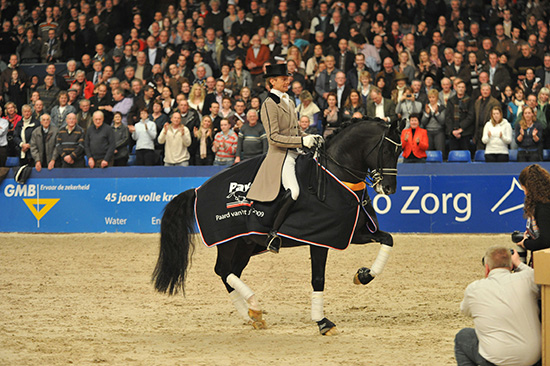
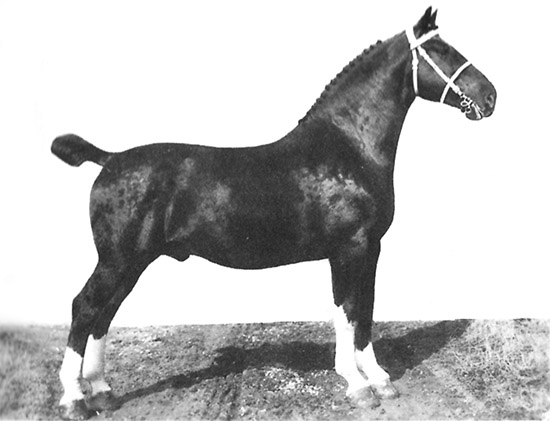
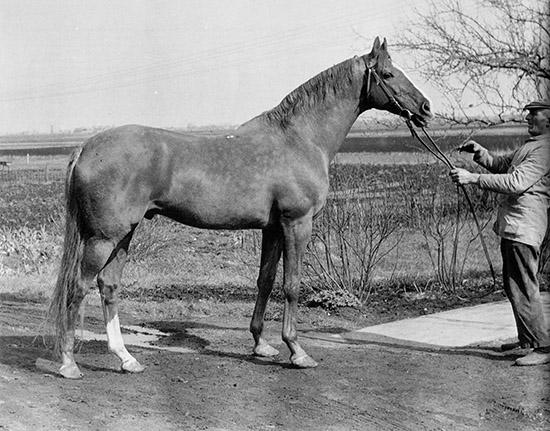

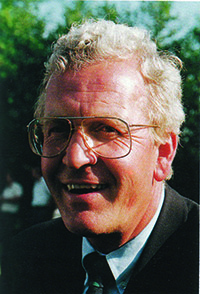
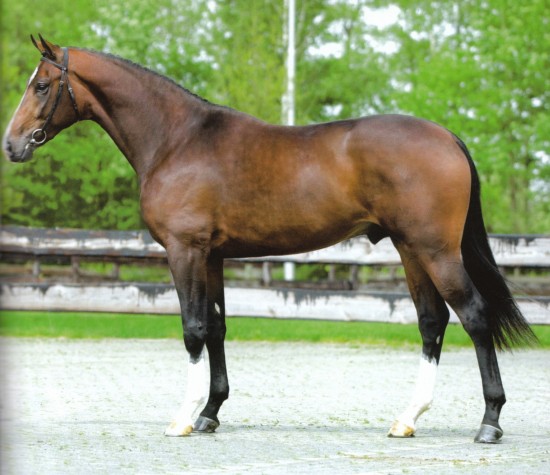
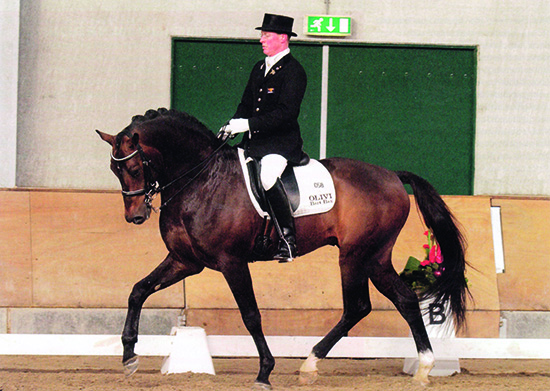
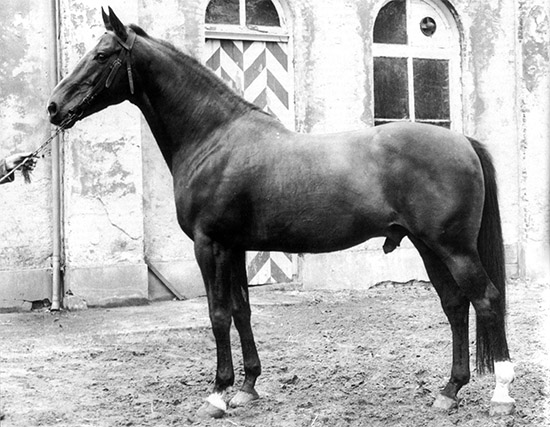
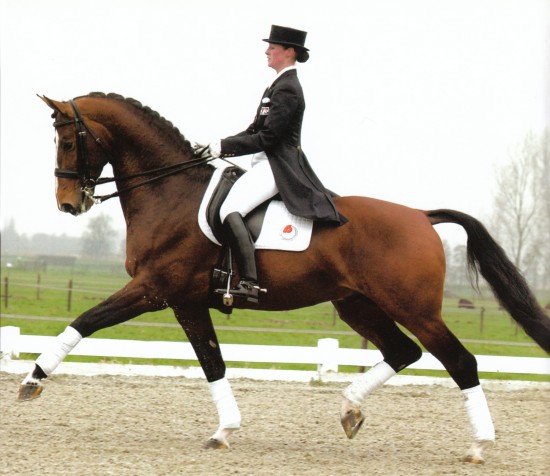
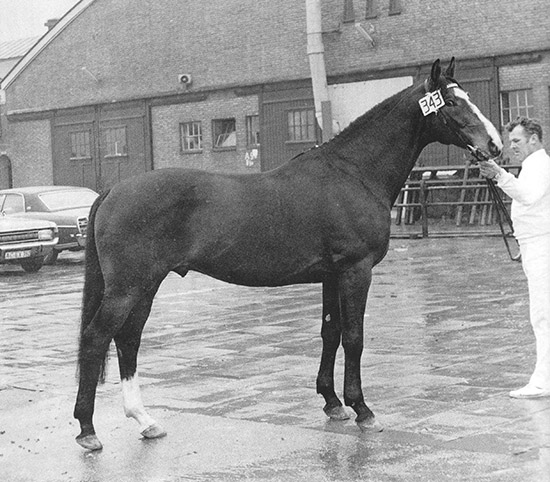
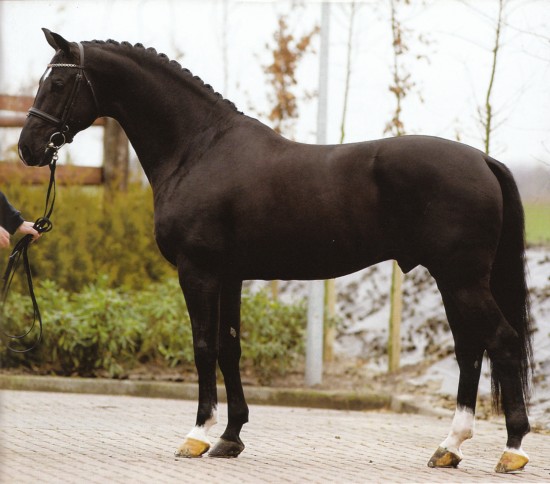
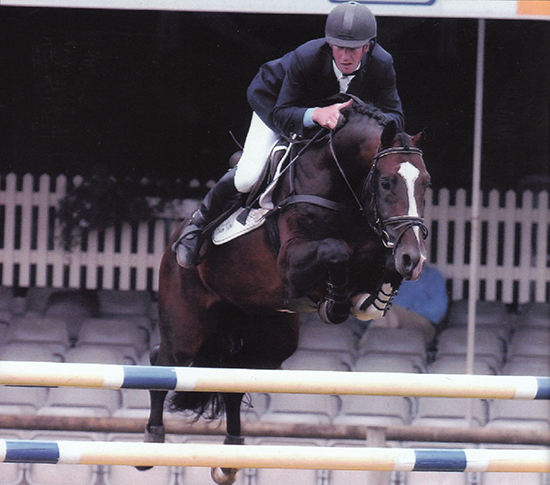
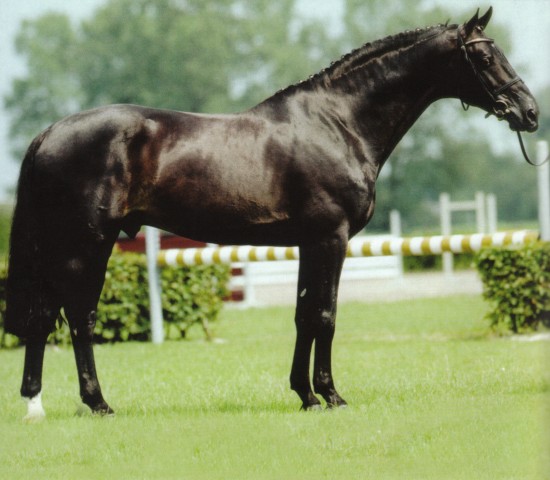
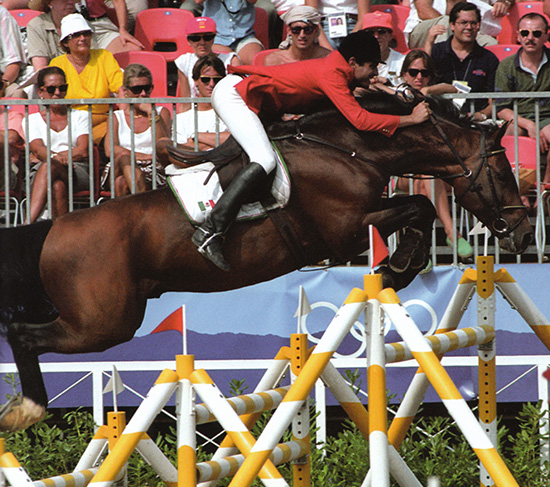
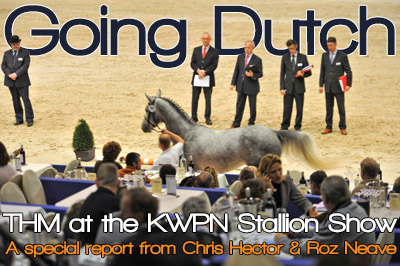
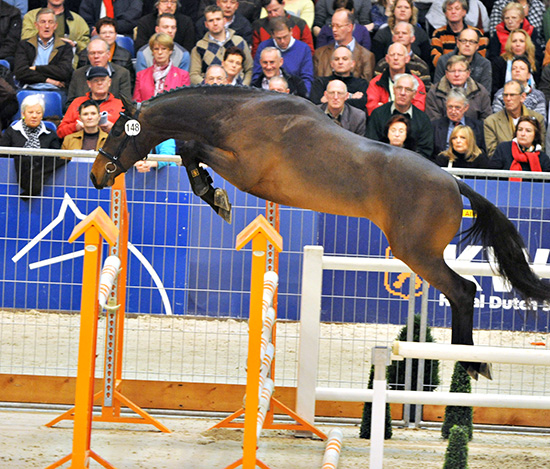
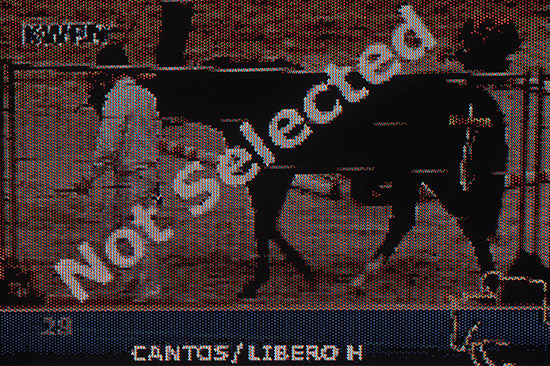

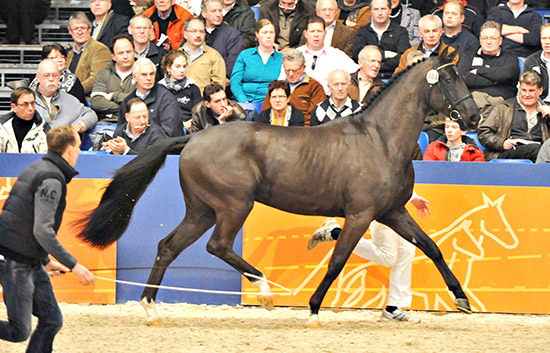
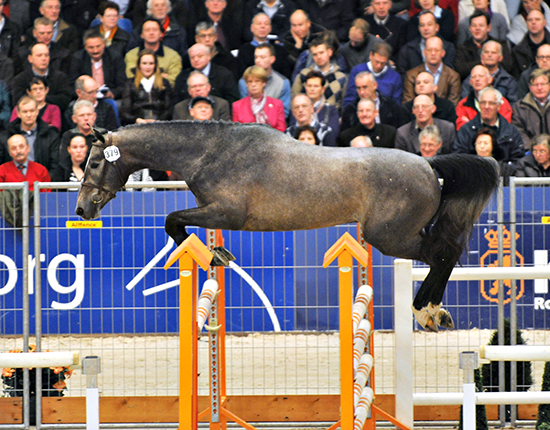
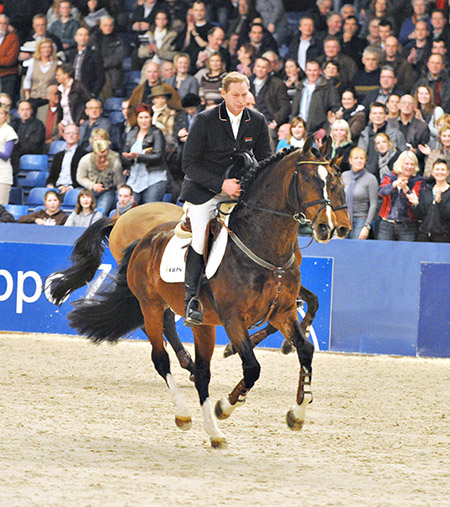
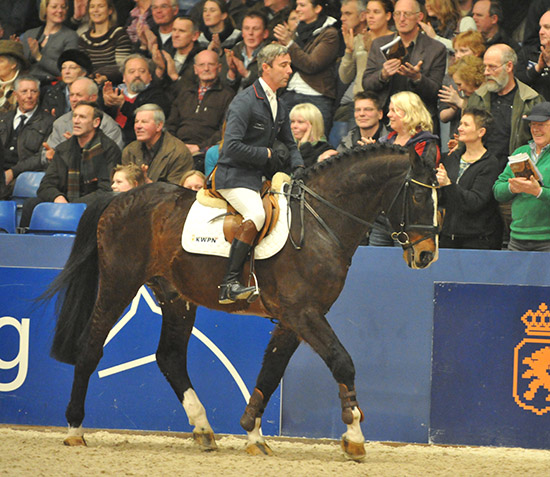
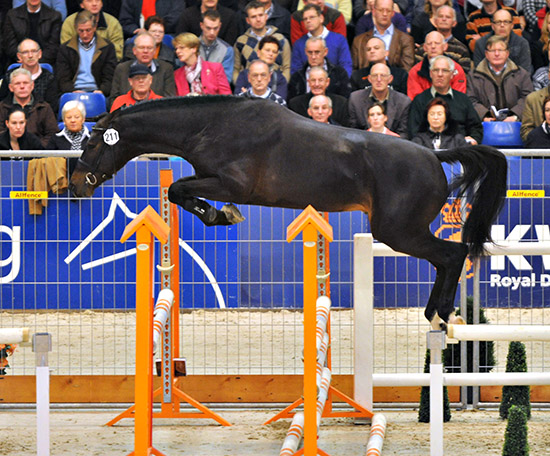
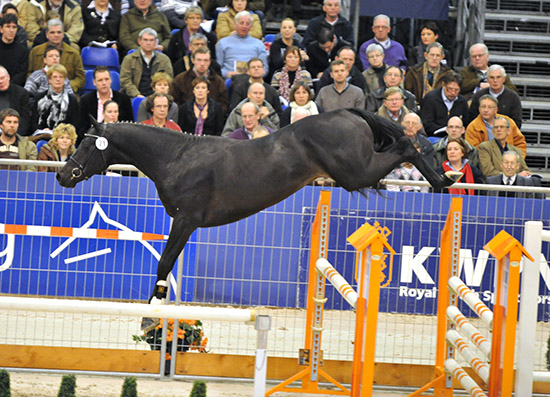
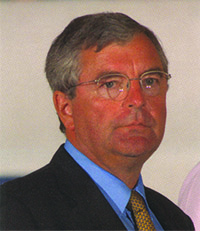
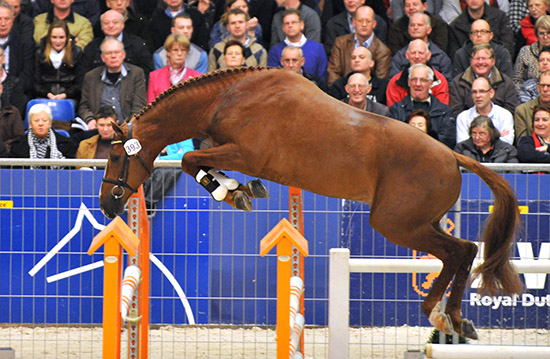
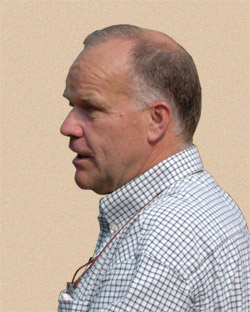
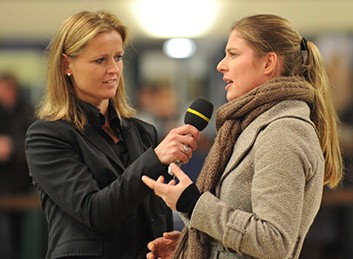
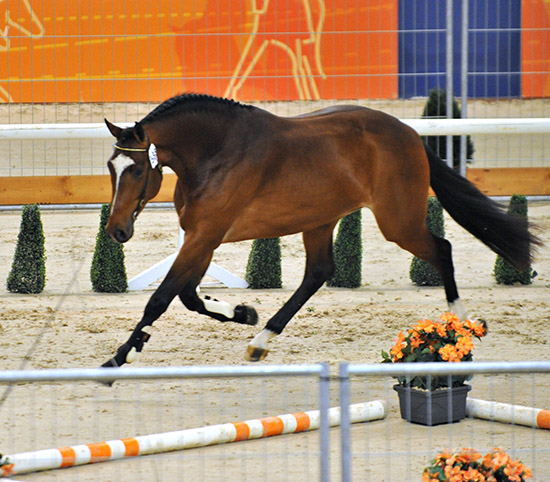
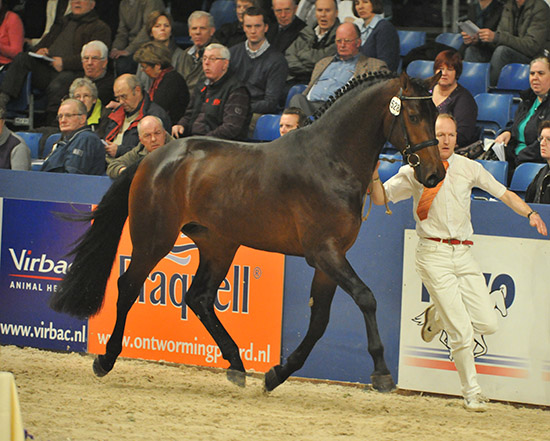
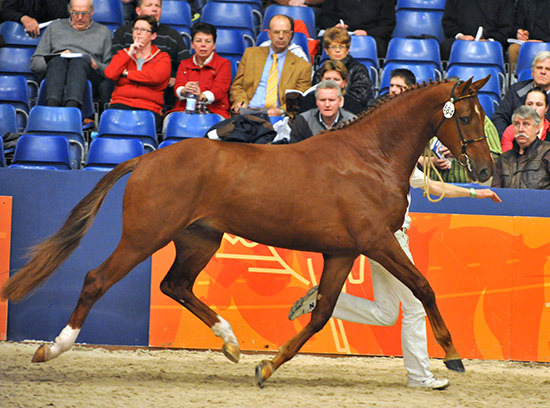
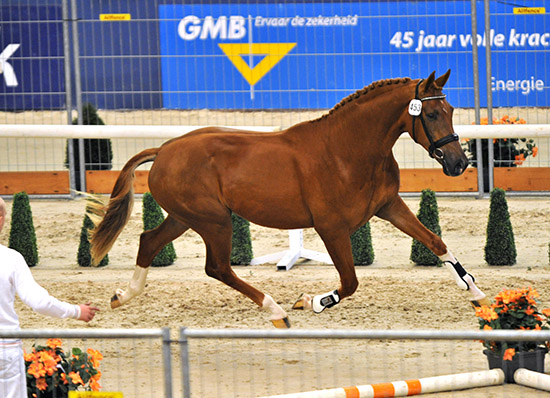
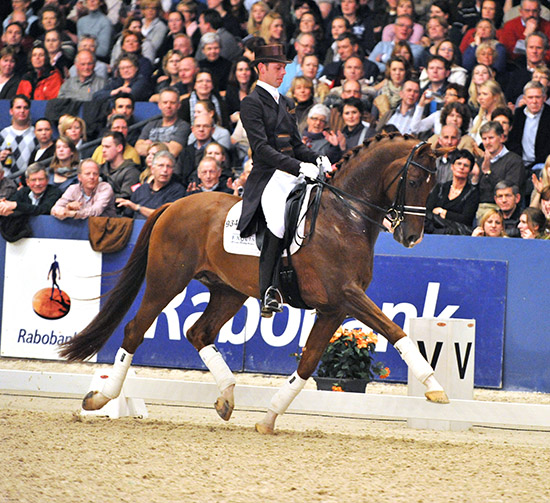
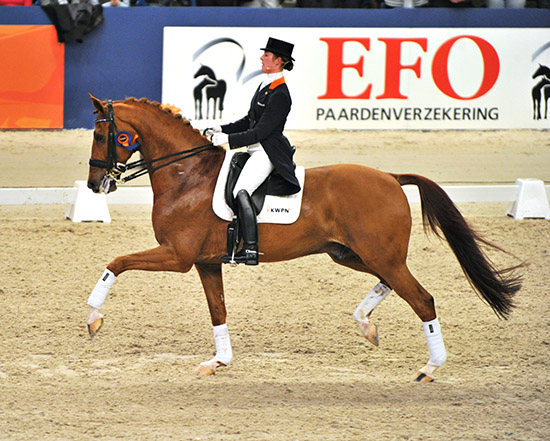
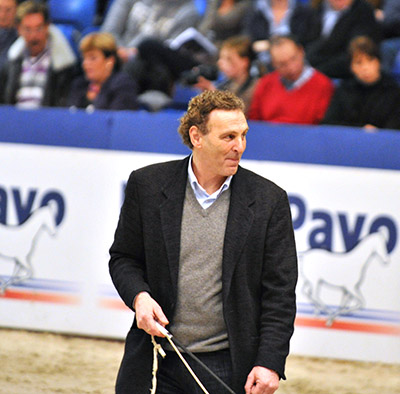
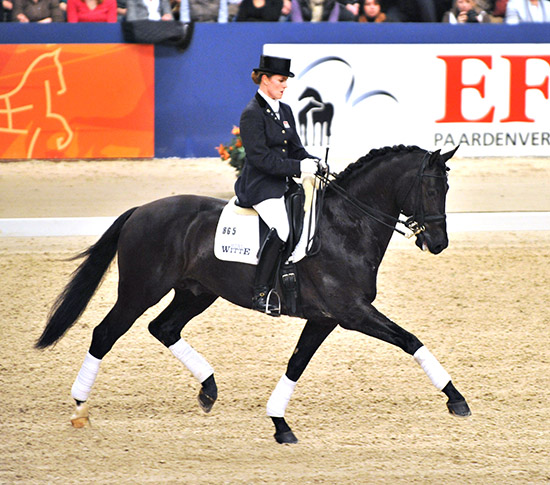
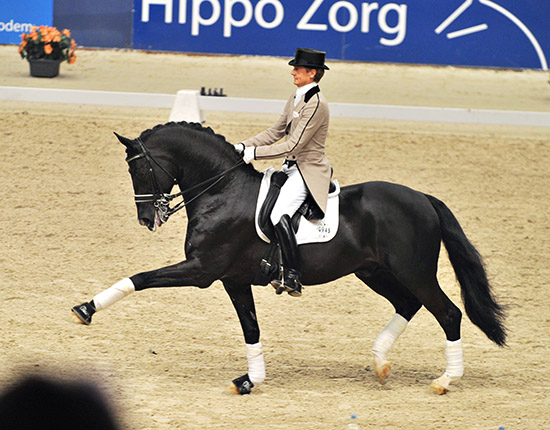
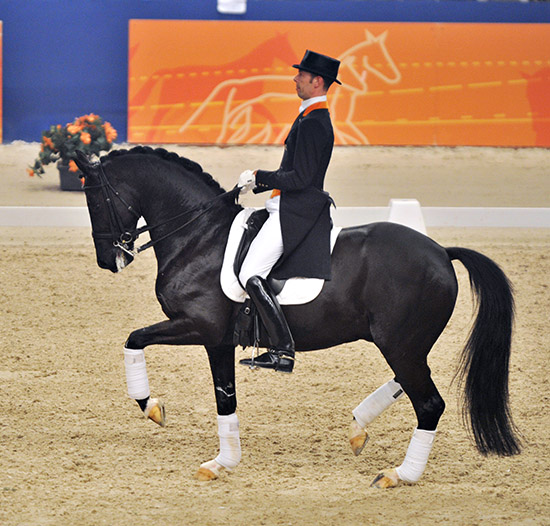
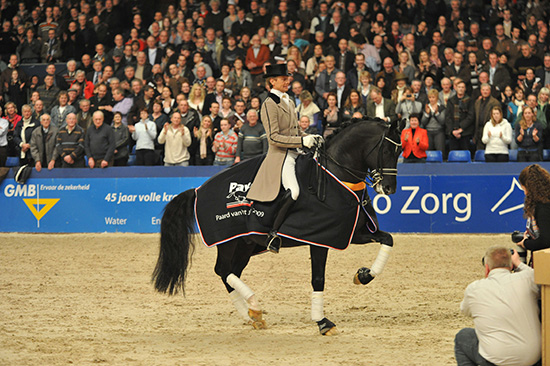
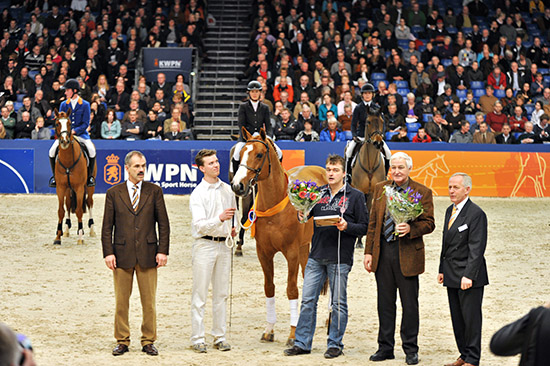
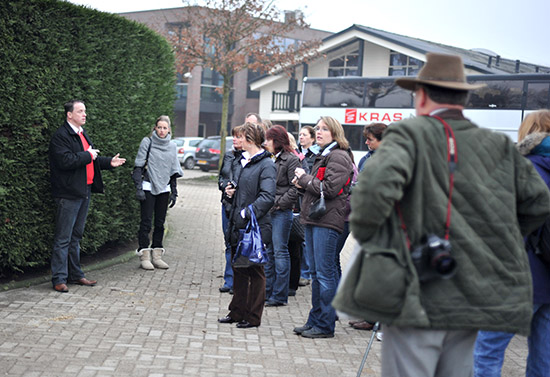
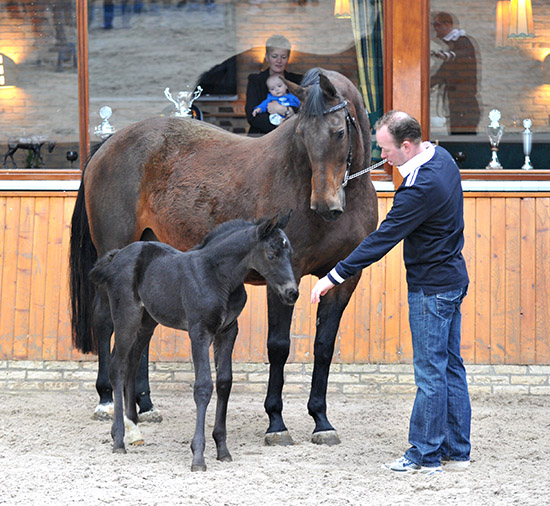
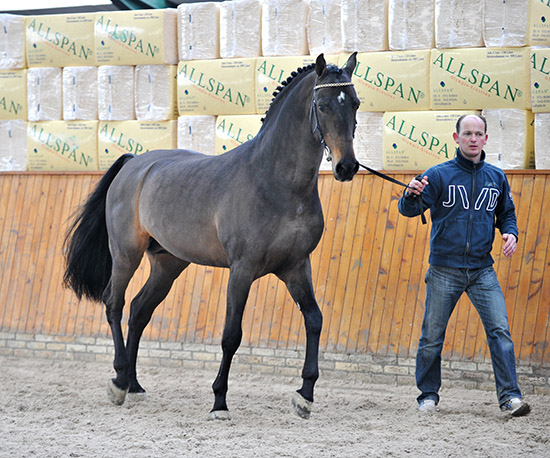
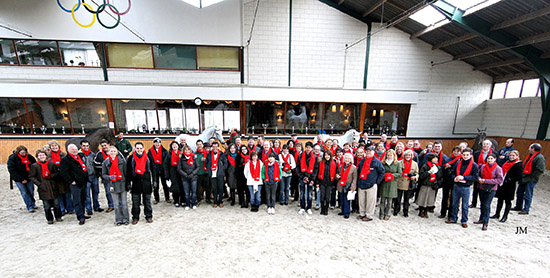
I own a beautiful looking & fabulous natured son of Winningmood.
He is Hercos Van T Smishof. Born in & registered as a Belgian Sporthorse in their Studbook & with the FFE.
I discovered & purchased him while in France in 2015 & spent some time there with him, where he awaits my return, …at his current home in mid west France.
He is only young (8yo in 2016), a great jumper & has inherited his Sire’s identical playful, very kind, cheeky, calm temperament.
He is the eyes of his sweet, sweet companion – Ysabel. An almost blind , Spanish – born, French Immigrant.
I love them dearly & long to get back to them – where I will relocate permanently.
My deepest gratitude goes to my friends Annemee & Patrick Van Aubel who kindly lodge & look after my 2 Beauties at their farm Cerfcheval in Luchapt France, till I return.